“This is far thicker than the 2.5 mm at which modern stainless lined copper maxes out.”
VFC says: Readers, you’re in for a treat. Reader Tyler K. discovered a line of antique copper-steel pans that upends the conventional wisdom that bimetal pans top out at 2.5 mm of thickness. Enjoy!

While tin is the traditional lining for copper and the most popular one among collectors, stainless steel has gradually taken up a larger and larger segment of the market.Most of what is sold today is based on bimetal technology developed by Falk in 1983 that allowed for the fusing of copper with 0.2 mm of 18/8 stainless steel under extreme pressure. The thickest of these reach 2.5 mm with 2.3 mm of copper.
Based on the textual evidence available, coppersmiths in France began developing stainless steel lined copper cookware in the 1960s. The benefits were apparent. Stainless steel is food safe, corrosion- and oxidization-resistant, doesn’t need to be retinned, and can be used with metal utensils without concern of scratching through the lining. These are the reasons why this type of copper cookware has become so popular today.

The downsides are just as apparent: Copper doesn’t bond with stainless steel the way it does with tin, nickel, and silver, and stainless steel is a terrible conductor of heat, meaning the layer has to be very thin so as not to take away from the benefits of cooking with copper. These downsides proved to be difficult to overcome with a high rate of failure and delamination (the two layers separating from one another) before Falk’s process in 1983 made steel lined copper much more prominent. A few decades prior and across the Atlantic, another coppersmith was dealing with these same issues.
 Joseph Heinrichs was a German-American Copper- and Silversmith based in NYC. Biographical info is a bit scarce on Heinrichs, but he was born in 1866 in Prussia and moved to the US in 1895. He started his own firm in 1897 making a variety of high-end copper and silver goods from cocktail shakers to coffee pots.
Joseph Heinrichs was a German-American Copper- and Silversmith based in NYC. Biographical info is a bit scarce on Heinrichs, but he was born in 1866 in Prussia and moved to the US in 1895. He started his own firm in 1897 making a variety of high-end copper and silver goods from cocktail shakers to coffee pots.
The company created a variety of pots and pans which he sold primarily to restaurants and hotels. This included copper lined with tin, copper lined with sterling silver, and pure nickel (definitely the thickest nickel pans I’ve found, but that’s another story). In 1937, the company went bankrupt and was reorganized as Legion Utensils, which is still around today.
I recently saw a bowl online from Heinrichs that had “KA-2” stamped on it, a marking I had never seen before.


What is KA-2? What was this bowl made of? Searching online revealed a few archived listings for Jos Heinrichs pieces labeled KA-2. Some of them were copper pans with this stamp and a mysterious metal interior. An old discussion online provided some guesses like nickel-silver or chrome but no conclusive answers. I found a single active listing for a copper pan stamped KA-2 which I eventually purchased, much to my wallet’s dismay.

After viewing the listing and doing more research, I was finally able to figure out what I was looking at: a copper pan lined with stainless steel. KA-2 refers to Enduro KA2, a brand name of stainless steel that was made by Republic Steel of Youngstown, OH. Below is from a 1930 marketing pamphlet for the metal.

This sauté pan was likely made in the company’s final years before going out of business in 1937. Jos Heinrichs was known for innovating and breaking norms such as lining many of his pans with sterling silver. It’s probably why this early example of a stainless lined pan exists, decades before other coppersmiths began producing stainless-lined cookware.
The pan itself is 8.24 lbs (3.7 kg) and measures around 10.2 in (25.9 cm) in diameter by 3 in (7.6 cm) in height.

The stainless steel lining on the interior stops slightly below the copper. Thickness varies slightly depending on where I measure it, from around 3.3 to 3.5 mm. This is far thicker than the 2.5 mm at which modern stainless lined copper maxes out. On my pan, around ~0.5mm of its thickness seems to be steel based on my measurements, more than the 0.2mm typical today.

Rather than copper and steel sheets being fused together like Falk’s method, Jos Heinrichs nestled a thinner steel lining into a thick copper shell. They were connected by spot welding. This can be seen in the spots on the pan below:


The spots are concave on the outside and very slightly convex on the inside. You can just barely feel it if you run your finger on the bumps inside the pan; not enough that you would notice while cooking.

The pan has the main stamp with maker and material along with another stamp under the handle stating that a patent was applied for. Unlike most copper cookware, the handle on this piece is rivetless.


This stamp led me to start searching for patents. Following the company’s bankruptcy, it was reorganized by Angelo Scavullo.

US 2,358,104 is a patent in his name that was applied for on April 11, 1940. It mentions that it is a continuation of an application from July 17, 1937. The patent shows an evolution of this design. It consists of two main ideas:
- The welding of a copper/zinc alloy handle onto a copper pan. This can be seen in the pan I purchased. Perhaps this means my pan was made in 1937 after the first application was submitted. Or perhaps there was an earlier patent application for just the handle that did not proceed.
- A method of making stainless lined copper different from both my pan and from modern methods. The patent details the formation of cookware by combining an inner layer of stainless steel with an outer layer of mild steel. Copper is then electroplated onto the outside of the mild steel to form a thick layer. When plated directly onto stainless steel, the copper was prone to peeling off or forming blisters. Legion’s new method created a more durable pan, though it likely suffers in thermal conductivity due to the thick steel layers.
Based on details from the patent and on images of cookware from Legion, the copper makes up around a third of the thickness at the rim but is thicker at the bottom. While its predecessor, Jos Heinrichs Corp, focused on the high-end luxury market, Legion Utensils pivoted to target a broader market of restaurants with more economical prices.

The patent was granted in 1944 and expired in 1961. This 3-layer design is still available for sale today according to Legion’s website.

So why did Legion create this complicated method rather than continue with spot welding? The patent itself presents a notable reason: “A number of utensils of this character were made by having the two metals tightly fitted together and spot-welded but this previously was not successful due to the danger of a crack forming between the metals and water going into the crack. In one case this crack became partially closed so that, on heating, the steam generated caused a rupture of the vessel.” It’s a piece of information that has led me to hold off on cooking with my new pan for now.
I have only found 5 other archived listings of KA-2 copper cookware. None of them have the spot-welds characteristic of my pan. One has an interesting flower-like pattern on the bottom of it. Two have rolled rims. The other two have none of these characteristics and appear to be a resale of the same pot based on measurements and scars. Ultimately, I don’t have a lot of data to go off of.


The variety of styles and limited number of listings makes me wonder if these were early prototypes. Or perhaps these were once more plentiful but have slowly disappeared due to their potential to fail. Either way, I’m happy to have a beautiful piece and to be able to share this newfound information on the history of stainless steel lined copper.
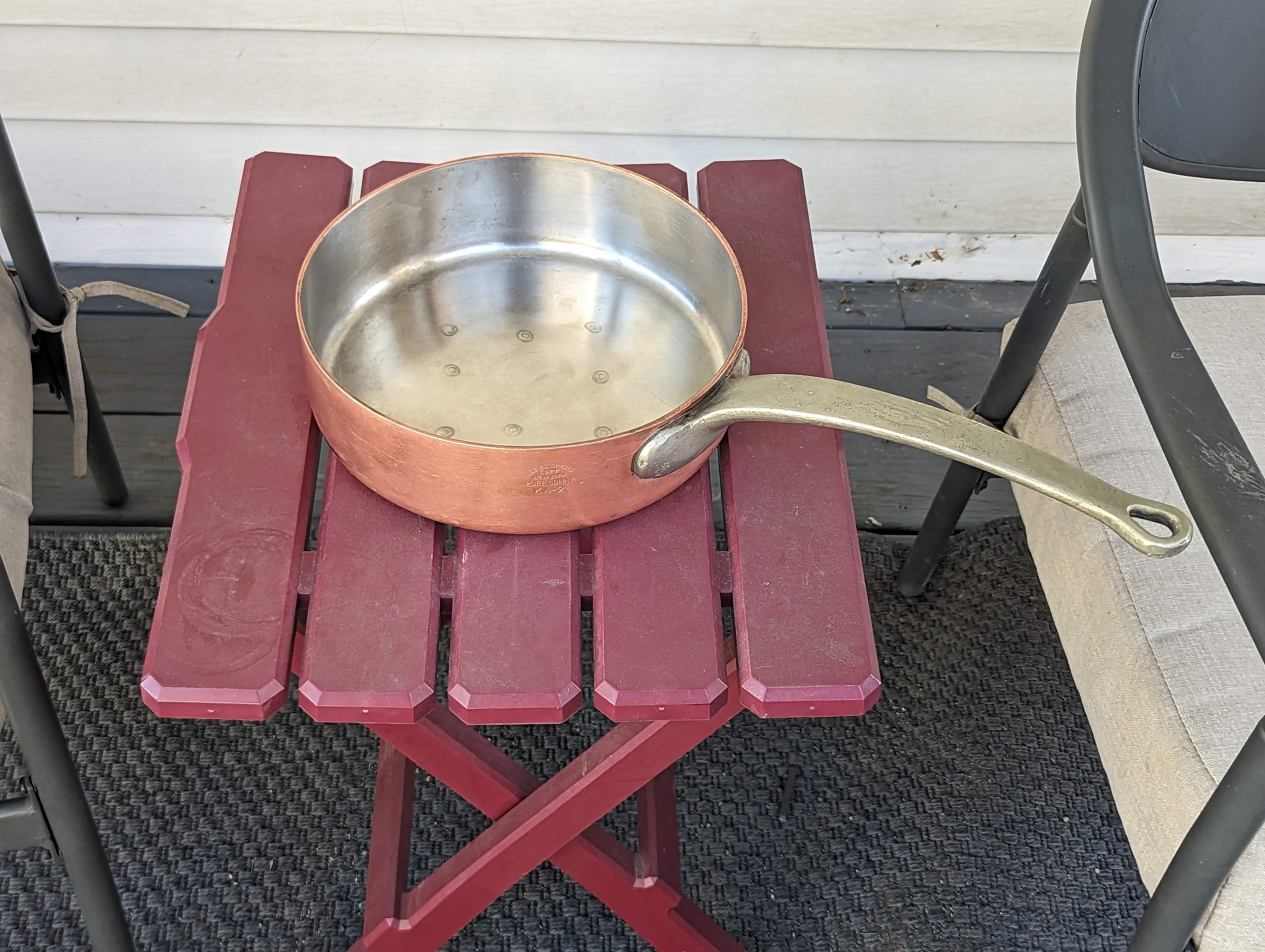
VFC says: Tyler, until you presented this research, I counted myself among the many vintage copper fans who insisted that all copper-steel bimetal pans cannot exceed 2.5mm of thickness. Thank you for compiling this research to debunk this mistaken belief! (I am now searching this site for these statements of mine and inserting a correction.) It does not surprise me that other companies investigated a different technique to produce copper-steel pans, but I am amazed that one such venture made it into production as early as the 1930s and that examples survive to the present day. Thank you for purchasing this pan and providing such clear photos and historical research to document its substantial thickness and how it was made.
And once again, I am reminded about the need for humility when it comes to this hobby. The universe of vintage and antique copper cookware may be limited to a finite number of pieces, but even so we continue to discover pans like this one that reveal innovations and variations that reveal the ingenuity and creativity of this industry. Thank you for capturing this information and making it available to the community.
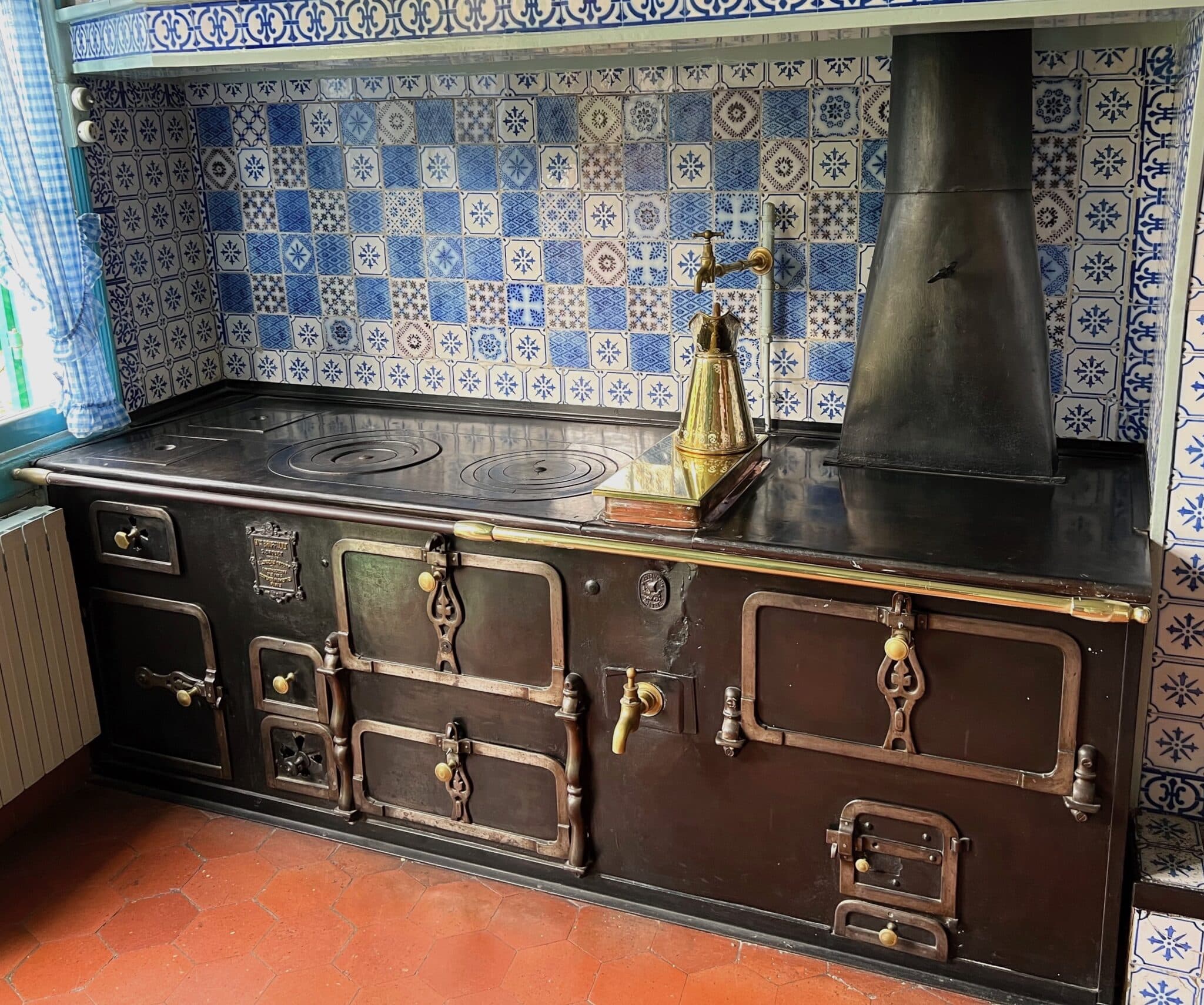
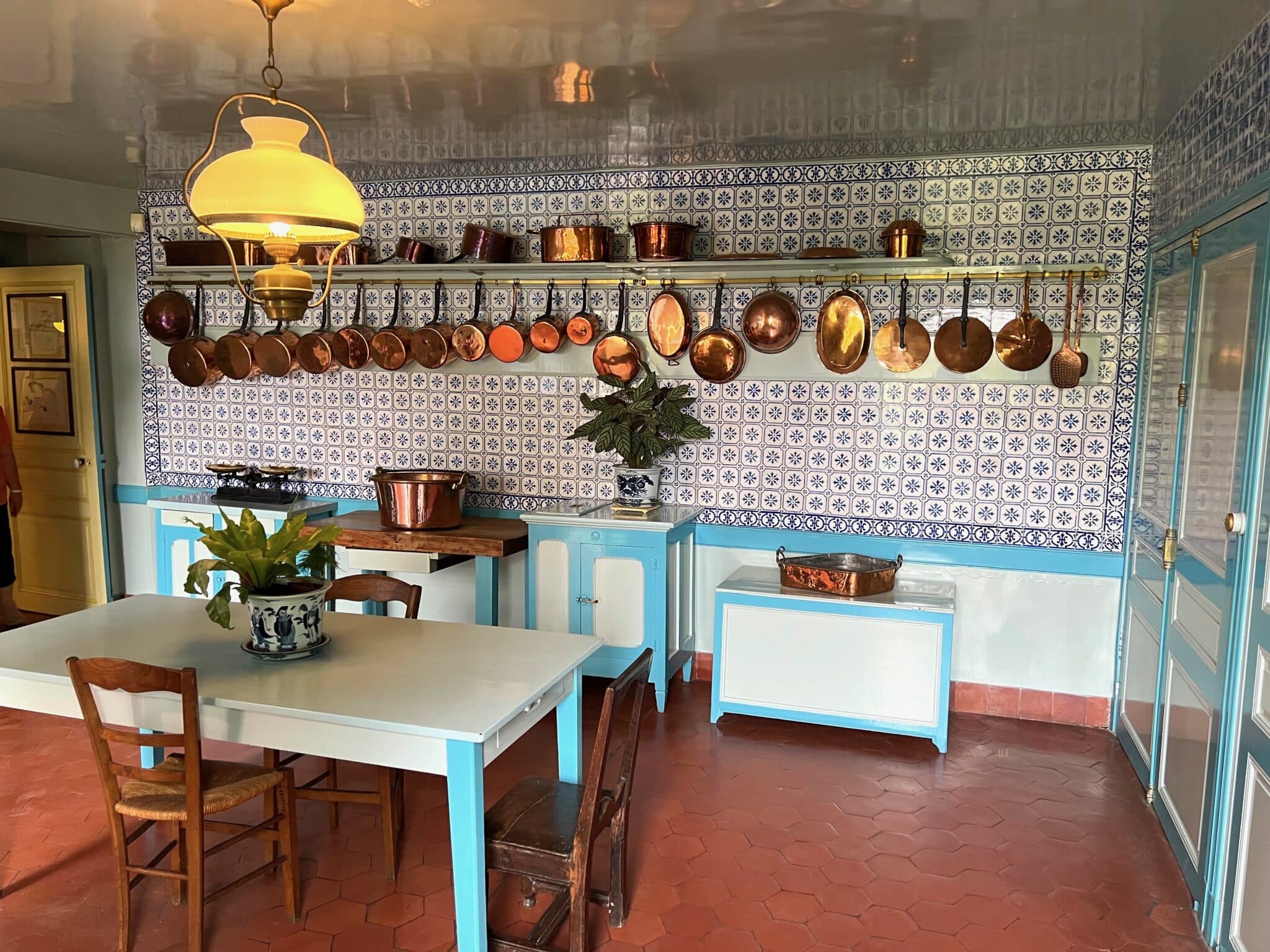
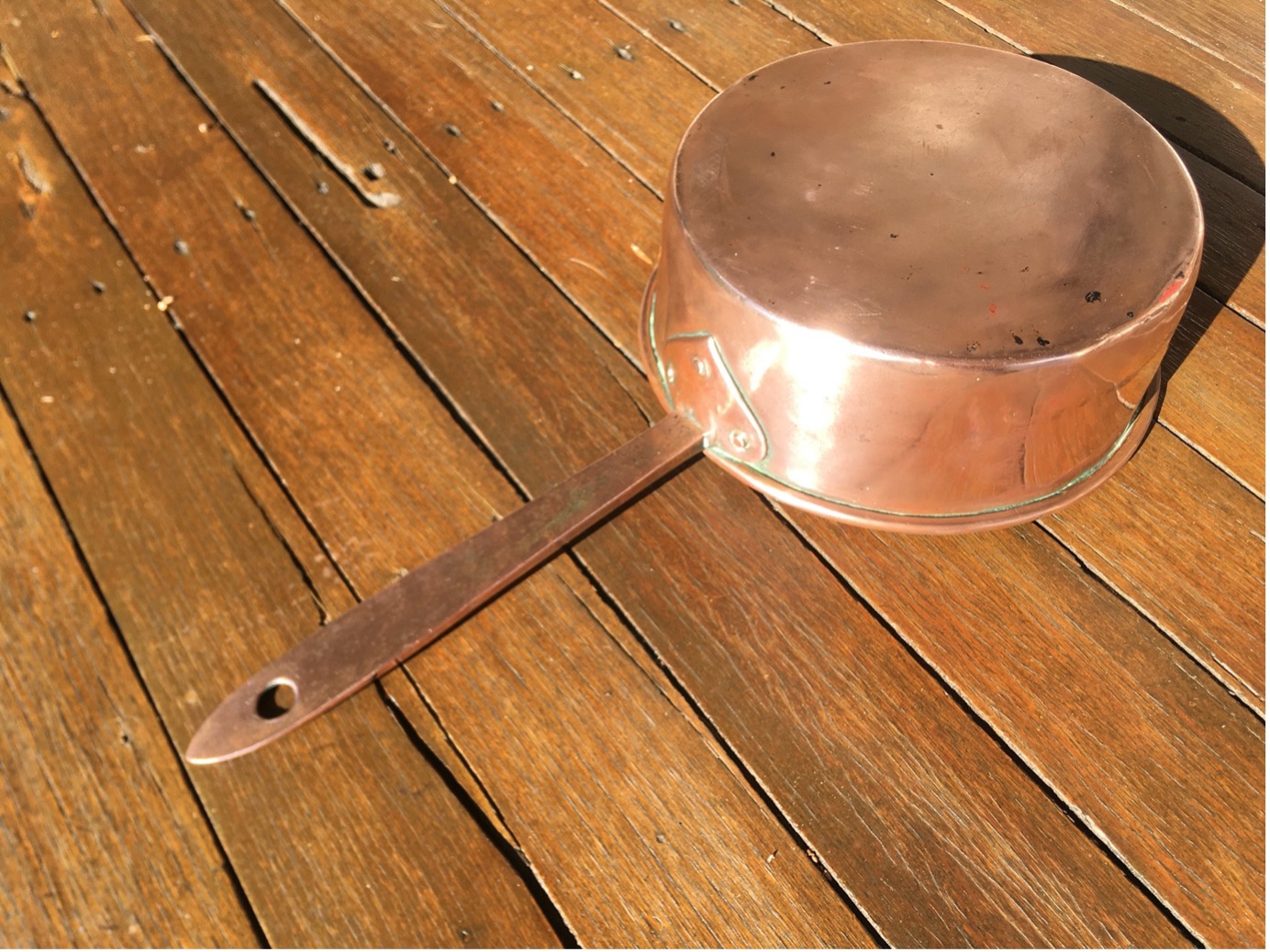
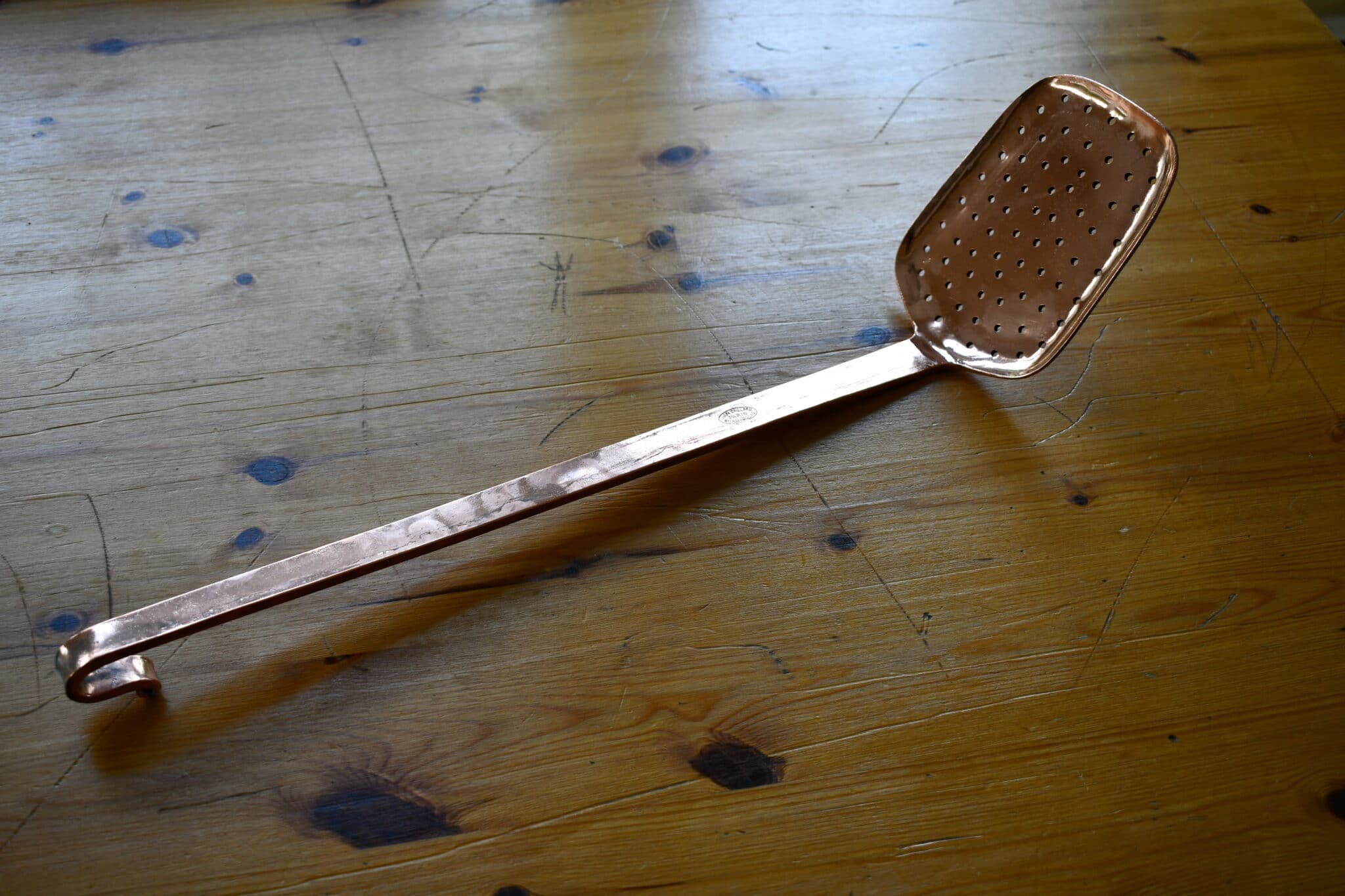
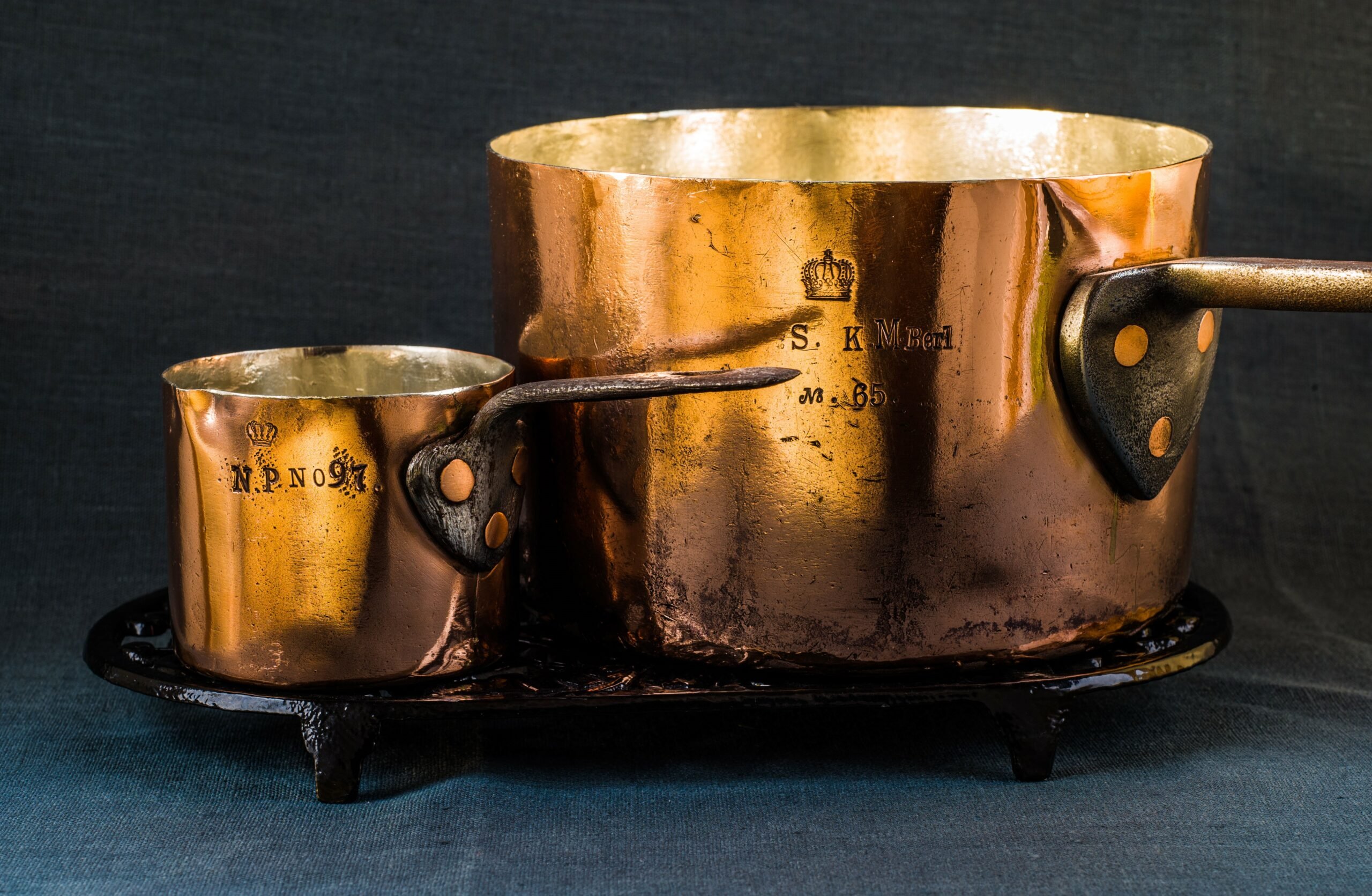
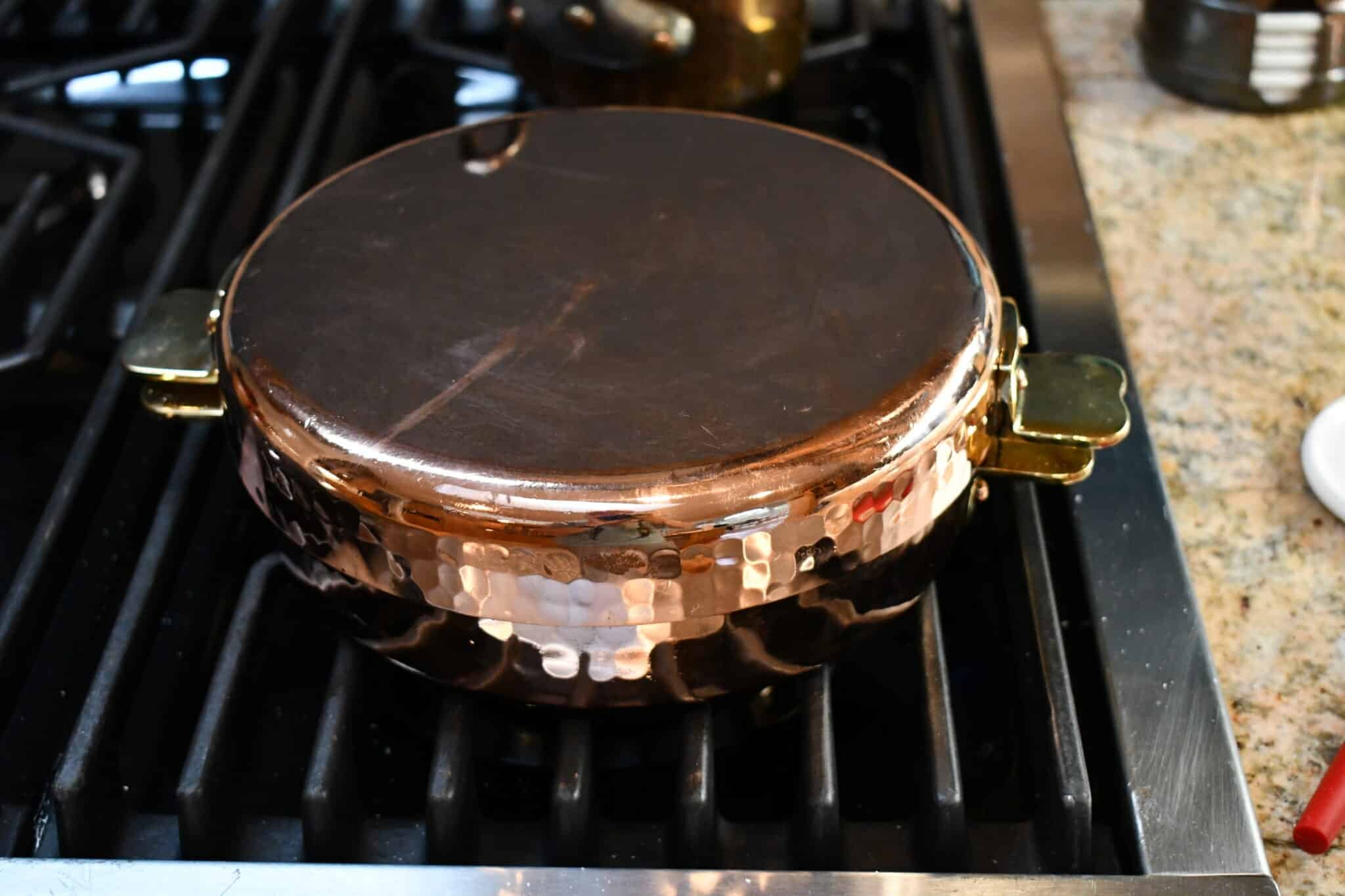
I was always under the impression that 2.5mm was a manufacturing limit, but I bought a Mauviel roasting pan a couple of years ago that is 3.5mm+, maybe even 3.7mm from memory. That is stainless steel lined. So this was an interesting write up
Hello Tyler,
wow, what an exciting and interesting research! And what a beautiful pan! Thanks for the pictures and the story behind it!
Amazing. And I absolutely love the rivetless handle.
Paul Manzoni, a Swiss manufacturer in the second half of the 20th century, attached brass handles to a range of solid copper serving products that were silver-plated on the inside, also without rivets. However, since I have seen photos of a roasting pan by this manufacturer, of which I cannot say with certainty whether it was silver-plated or tin-plated on the inside, I assume that this technique of attaching the handles was also extended to other series in later years (from around 1980). For example, also on fish kettles (poissioneres), which I have seen in the Manzoni catalog. My silver-plated poissonniere, stamped by Beard, Montreux, a respected silverware manufacturer, whose brass handles also do without rivets, corresponds exactly to an illustration in the Manzoni catalog. Who was the manufacturer, who the supplier?
As a collector of Jos Heinrich’s I found this additional history and knowledge fascinating. Thank you
Thanks so much for the opportunity to share this and contribute to this site!
How does it cook?
Bob, I haven’t cooked with it yet. The old story of another one of these rupturing has me a little worried about damaging it. I’ll probably use it eventually though.
An attitude to life “that admits that I can be wrong, that you can be right and that together we might get to the truth” (POPPER) is not the worst.
Thank you for the new insights!
Here is a tidbit. Fitted lids have an edge width of ~ 7mm. I finally found and bought a fitted lid for for my 12cm Matfer in pot. I got a five piece set from 12cm – 20cm. I guess it’s a 1970s set. Well, I get the fitted lid and what do I find.
It does not fit. The angle on the handle does not allow a lid. The handle touches the top edge of pot, no space; so the maximum width of the lid is the copper pot thickness, a little more than 2 mm. This set is 2.5 – 2.8 mm.
Anyone have experience with this? Maybe the 12 cm pots are not intended to use fitted lids? I may buy a milk pot, a taller 12 cm pot for heating milk with flavoring, just to use the lid. Such pots tend to be tall to help reduce boil over, or keep the milk. So, I guess. And the handles tend to be lower than the top.
This fitting issue may explain why 12cm lids are extremely rare. Took me 4 years to find one.
Bob, finding suitable lids for pans is really not easy. This can keep you busy for years if you can’t buy the pan and lid together, as is the case with new items. The problem is the design of the pan handles. With many, perhaps even most handles (especially with frying pans), the bend only starts at the height of the pan rim. The handles are very close to the pan at the bottom. As lids always have a small overhang, i.e. a slightly larger outer diameter than the pans, this handle design does not leave the lids the necessary space. The exception is the very flat lids, which are not really tight-fitting. Fortunately, there are also handles with a suitable design that leaves some space above the mounting plate between the pan and the rest of the handle. With some handles, the bend starts directly above the mounting plate, so it moves away from the pan early on. For a while, Mauviel had a special design that left plenty of room for lids. I find it very unfortunate that Mauviel has not retained this design.
Another difficulty arises from the fact that the manufacturers’ measurements are more of a guideline. The production of historical pans was not as precise and the material thickness varied. Even the lids of the modern, stainless steel-clad pots from Mauviel, Bourgeat and Falk are only partially interchangeable or not interchangeable at all for the respective sizes.
The AI of DeepL is unfortunately too independent and always changes translations at the last moment when I am inserting a text. Why doesn’t the AI consult with me? I hope the above comment is still reasonably understandable.